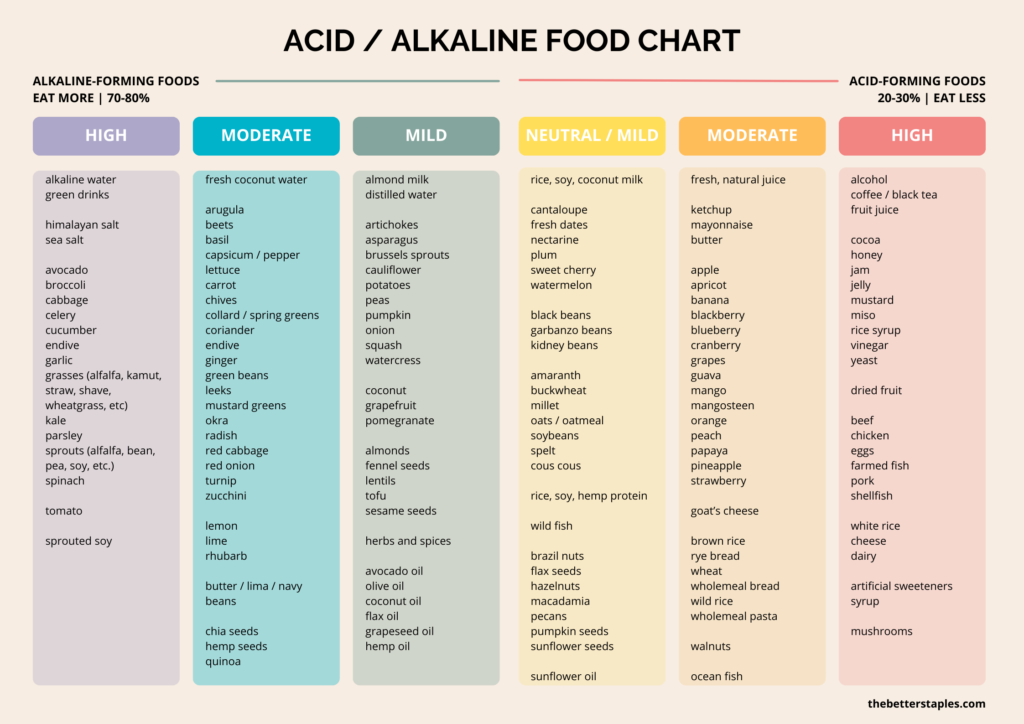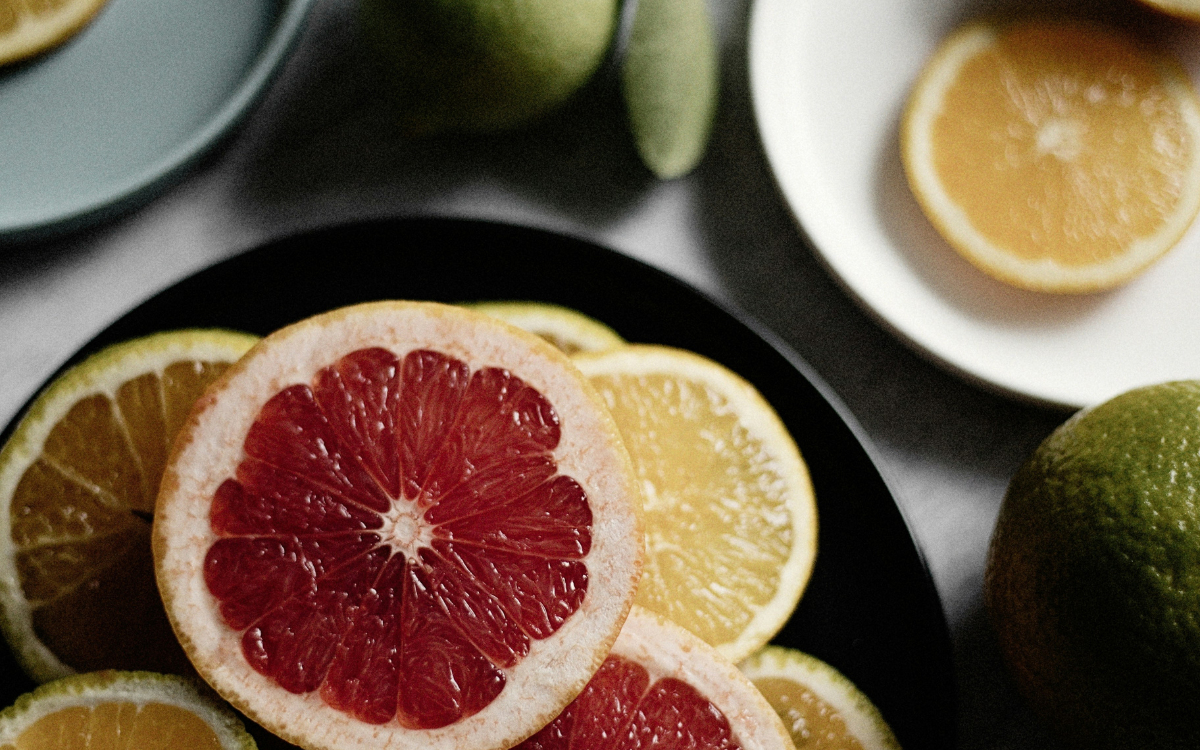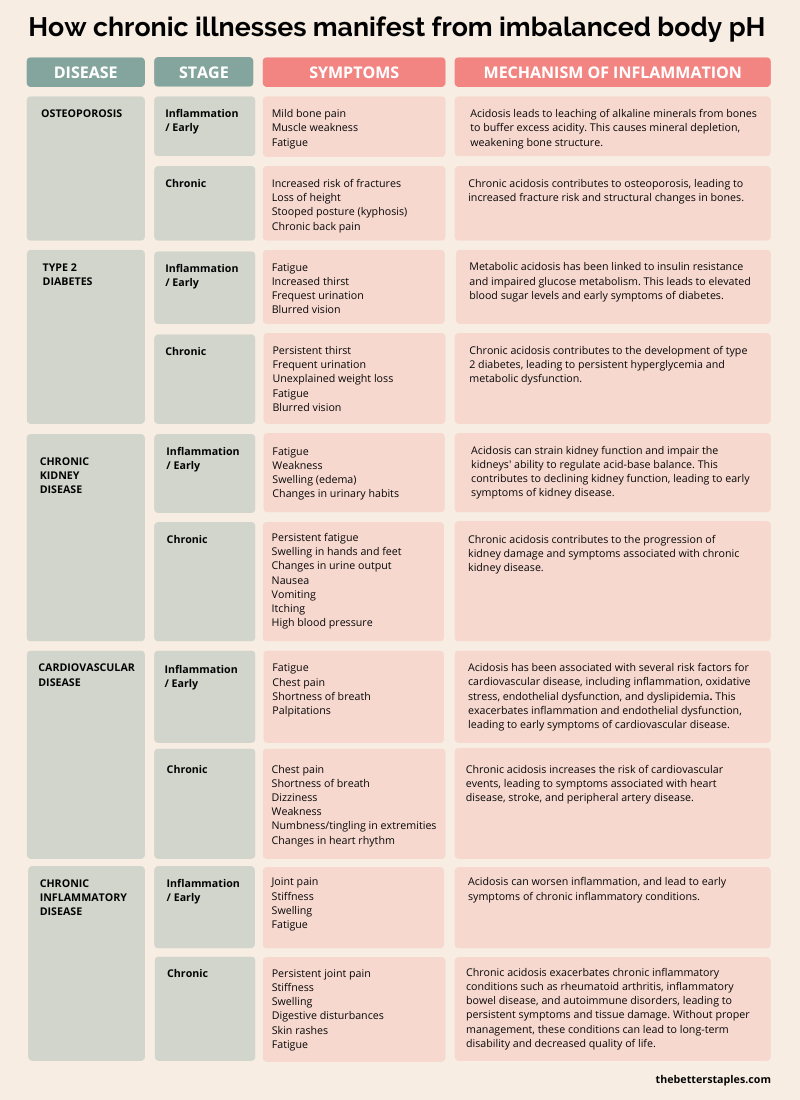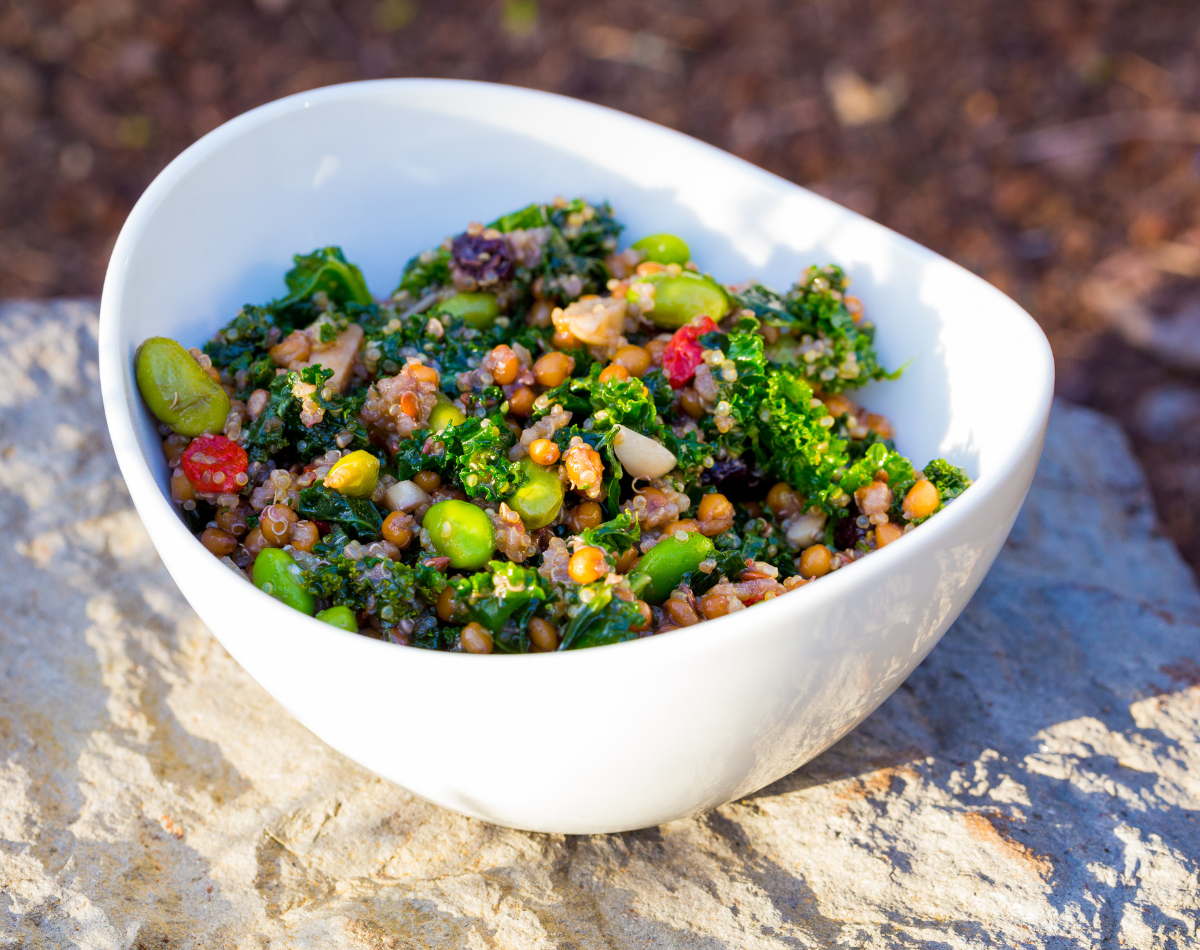80/20 –that’s the rule to remember.
The Acid-Alkaline Food Concept
The acid-alkaline food philosophy is the first dietary concept that I explored at the start of my wellness journey. The concept is introduced by Dr. Robert O. Young, an American naturopathic practitioner, and author of the book “The pH Miracle: Balance Your Diet, Reclaim Your Health.”
This dietary concept is rooted in the belief that our body functions optimally when our internal environment is slightly alkaline between pH7.35 and 7.45, measured by our blood. An acidic environment on the other hand leads to inflammation, and is the root cause of many diseases and health issues.
Our body is a sophisticated machine, always working to keep our body in balance. When there’s occassional excess acid in the blood or tissues (a condition called acidosis), the body activates various mechanisms to redistribute or eliminate them through the organs such as kidneys and lungs. We have a very efficient self-cleaning machine within us.
Having said that, it is possible to overwhelm our body, as in the case of persistent acidosis, which leads to inflammation. Here’s when we begin to experience a variety of symptoms that many of us are familiar with, live with, and made to believe is normal, but truly isn’t. Such symptoms include brain fog, skin issues, headaches, allergies, flu-like symptoms, rashes, mood swings, and anxiety, to name a few.
As inflammation persists, chronic conditions occur. Here are some examples of how chronic illnesses can manifest from an imbalanced blood pH:
“Symptoms are not the start of the problem, they are the last straw. It is a sign your body is already overwhelmed. “
Dr Jess Reynolds
An acid-alkaline imbalance also encourages the growth of microforms. Microforms are yeasts, fungus, and molds as well as bacteria and viruses. Not only are we at risk of nurturing these undesirable microforms with an acidic environment, we are also at risk of being intoxicated by their toxic wastes (which in itself is acidic). These wastes are created from digesting the glucose, proteins and fats in our body, the very same substances our body use for energy. This would mean that their thriving existence also interferes with our nutrient absorption.
Microform overgrowth causes infections. You would have noticed, especially during the recent pandemic, how different people with the same exposure, responds differently. Some people fall terribly ill, yet some show no signs of infection. Why? Because seeds thrown onto concrete will not grow. They have to be on fertile soil. Bugs may enter our system but our internal environment determines whether they thrive or die.
As they thrive, waste is inevitably produced. This adds to the acidity of the internal environment, and gives rise to a huge list of symptoms. Again, a lot of these are symptoms that we’re very familiar with but are unaware that they are warning signs from our body to address the underlying bodily issues.
Such symptoms are pain, infection, fatigue, and body malfunctions including adrenal/thyroid failure, indigestion, diarrhea, food cravings, intestinal pain, depression, hyperactivity, antisocial behavior, asthma, hemorrhoids, colds and flu, respiratory problems, endometriosis, dry skin and itching, thrush, receding gums, finger/toenail fungus, dizziness, joint pain, bad breath, ulcers, colitis, heartburn, dry mouth, PMS and menstrual problems, irritability, puffy eyes, lack of sex drive, skin rash and hives, lupus, mood swings, hormonal imbalance, vaginal yeast infection, cysts and tumors, rheumatoid arthritis, numbness, hay fever, acne, gas/bloating, bowel stasis, low blood sugar, hiatal hernia, headaches, lethargy/laziness, insomnia, suicidal tendencies, cold-ness/shakiness, infections, over-and underweight conditions, chemical sensitivity, poor memory, muscle aches, allergies (airborne/ food), burning eyes, multiple sclerosis, malabsorption, bladder infection, and more…
“… no matter what the symptoms bothering you, the immediate causes are always the same: acidity and microform overgrowth”
Dr Young
Microform overgrowth can also interfere with nutrient absorption. These bad bugs compete with the good ones, as well as the body’s cells for nutrients. They can also damage the lining of the gut where nutrients are absorbed. Damaged gut lining also causes leaky gut syndrome, where undigested food and toxins enter the bloodstream, triggering inflammation. Digestive enzymes activity that helps the body break down food particles is also disrupted. In more severe cases, microform overgrowth can give rise to conditions such as celiac disease, Crohn’s disease, and irritable bowel syndrome (IBS).
While all of these sound concerning, all hope is not lost. We CAN reverse the condition of our blood pH. All we have to do is create an internal environment that does not support the microforms, and balance your blood as well as tissue pH with nutritional supplements, probiotics, and an alkaline diet.

“To maintain health, the diet should consist of 80% alkaline-forming foods and 20% acid-forming foods.”
Dr Young
How do we define Acid or Alkaline Foods?
Before we begin understanding acid-alkaline foods, it is worth noting that various non-dietary factors could contribute to an acidic internal environment. This includes stress, metabolic processes, environmental toxins, medications, and poor sleep habits. I will expand on this in a seperate article / guide. In this guide, we will focus on food.
Dr Young classifies acid-alkaline foods based on the effect they have on the body after they have been consumed. In this case, the blood pH is measured.
If you’ve delved into acid-alkaline food charts, you may have noticed discrepancies amongst them. One other way food pH is being measured in similar researches is using the Potential Renal Acid Load (PRAL). This method involves burning food at extremely high temperatures and then measuring the pH of the resulting ‘ash.’ The high temperatures used in this process eliminate much of the acidic components of the food, particularly sugars. Consequently, some fruits with high sugar content are mistakenly labeled as alkaline in certain charts. Such charts, therefore, will not be the most accurate to use as reference.
The Acid-Alkaline Food Chart

Acid Alkaline Food Chart, https://phoreveryoung.wordpress.com/
How to use the Acid-Alkaline Food Chart?
Based on the chart above, 70-80% of our diet should consist of alkaline-forming food. Meanwhile, acid-forming foods can form the other 20-30%. These are measured visually, not by weight or calories.
Here are the key points differentiating acid-forming foods from alkaline-forming foods:
Acid-Forming Foods / What to eat less of:
- Sweet fruits: Sweet fruits are high in sugar which ferments in our body. This feeds microforms. In a healthy body, one portion of fresh sweet fruit a day is tolerable. Avoid fruit juices.
- Legumes: The unsprouted or canned ones especially are to be avoided. Legumes are high in carbohydrate as it is primarily starch. Starch turns into sugar in our body, resulting in acidity. Sprouted legumes can be consumed in limited quantities.
- Processed Foods: Highly processed foods, such as fast food, sugary snacks, and refined grains like white bread, pasta are devoid of nutrients. On top of that, they are loaded with sugar, salt, artificial colorings and flavourings, additives, preservatives and usually made with refined oils. These are highly acidic to the body.
- Animal Proteins: Foods derived from animal sources, including meat, dairy, and eggs, are often acidic and mucus-forming. Fish high in Omega-3 oil from unpolluted water is a better option. Other animal protein can be included in the 20% of our diet, but choose high quality meat – grass fed, organic, free-range.
- Sugar: Foods and beverages that contain sugar are to be minimized, especially those containing artificial sweeteners as they are toxic to our body. Safe sweeteners to use would be those from natural plant sources, which are also low in GI, such as the herb stevia.
- Caffeine and Alcohol: Beverages like coffee, tea, and alcoholic drinks are acidic and can disrupt pH balance, with the exception of herbal tea.
- Certain Grains: Wheat and rice are acid-forming, especially the refined varieties. Grains generally can form a small part of a healthy diet, choose wholegrain varieties, ideally within 3 months from harvest.
- Processed Oils: Fats are essential but the wrong kinds can cause clogged arteries, heart disease, cancer and so on. As a general rule, minimize refined oils, animal fats (except for fish), and vegetable oils including margarine.
Alkaline-Forming Foods / What to eat more of:
- Leafy greens: Dark, leafy greens provides vitamins and minerals, fibre, enzymes, phytonutrients (i.e. chlorophyll, bioflavanoids), and alkaline salts that control microforms and their mycotoxins. Vegetable juices and broth are two other ways to consume leafy greens. Fresh is best, organically grown is preferable. Raw is more alkalizing than cooked.
- Non-sweet fruits: Lemon, lime and grapefruit are alkalizing in our body, they contain very little sugar, and has an abundance of oxygen. Microforms do not live well in the presence of oxygen. Tip: Squeeze fresh lemon or lime into purified water and drink throughout the day. Tomato and avocado are also low in sugar.
- Grasses: Grasses are incredibly nutrient-dense, even more so than vegetables. The easiest way to consume grasses is in the form of supplement.
- Sprouted nuts and seeds: Sprouted nuts and seeds, made by soaking prior to consumption, increases digestibility, are alkalizing, and life-generating. They are high in enzymes, predigested complete proteins, chelated minerals, nucleic acids, vitamins, RNA, DNA, and vitamin B12.
- Sprouted legumes: Sprouted legumes can be eaten as part of 20% due to the starch content. Sprouted soy and lentils on the other hand are primarily protein, and can be included as part of 80%.
- Neutral grains: Whole grains like quinoa, millet, spelt, amaranth, and buckwheat groats are rather neutral, and does not contribute to formation of sticky mucus. Buckwheat groats and millet specifcally are high in protein and digests slowly. This keeps the blood sugar balanced.
- Healthy fats: 20% of our diet should come from fats, essential fatty acids to be specific. This is found in olive oil, avocado and avocado oil, raw sprouted nuts. Fish rich in omega-3 oils is a good choice as it also contains protein and several nutrients. Think SMASH (salmon, mackerel, anchovies, sardines and herring) from fresh, unpolluted water.
- Water: Drinking water with a slightly alkaline pH can help maintain overall pH balance in the body. Adding squeezed lemon or lime, or consuming vegetable juice is alkalizing.
How does food contribute to the acidity / alkalinity in our body?
When we eat, our bodies break down the food into different parts, and this process affects how acidic or alkaline our body becomes. The overall impact of this process on our body’s pH balance is called the net acid load. Let’s break down how different types of food affect this balance:
Protein Metabolism: Foods that are rich in protein, like meat or beans, produce acids when they’re broken down. This happens because proteins contain certain building blocks that release acids when they’re used for energy. Foods with lots of animal proteins tend to make our bodies more acidic compared to plant-based proteins.
Carbohydrate Metabolism: Carbs are turned into glucose, which gives us energy. While carbs themselves don’t really affect our body’s acidity, the kind of carbs we eat can indirectly influence it. For example, sugary snacks and white bread can make us more acidic because they lack minerals that help balance acidity. On the other hand, whole grains, fruits, and vegetables have minerals that can make our bodies less acidic.
Fat Metabolism: Fats are broken down into smaller parts during digestion. While fats themselves aren’t acidic or alkaline, unhealthy fats from fried or processed foods can lead to inflammation, which can make our bodies more acidic. But healthy fats, like the ones in fish or nuts, might help balance our body’s pH.
Mineral Absorption: Minerals like calcium and magnesium can help counteract acidity in our bodies. However, if we don’t absorb these minerals well from our food, our bodies might become more acidic. For example, phytic acid that exists in nuts can make it harder for us to absorb helpful minerals. Understanding proper method of preparation can deactivate these protective mechanism and make them more digestible.
Food Processing: When we cook, bake, or refine foods, it can change how acidic or alkaline they are. For instance, when we cook meat at really high temperatures, it can create acidic compounds called AGEs. And when grains are refined, like making white bread from wheat, it takes away some of the good stuff that helps balance acidity, like fiber and minerals. So, how we prepare our food can affect its acidity level and how it impacts our bodies.
Overall Diet: Finally, it’s not just about individual foods—it’s about our whole diet. If we eat a lot of acidic foods and not enough alkaline ones, or if our meals are out of balance with too much protein, fat, or carbs, our bodies might become too acidic over time. This chronic acidity can lead to health issues.
My thoughts on the criticisms towards the Acid-Alkaline Food Concept
Dr. Young’s idea is not without criticisms. Some of the criticisms include doubts about its scientific evidence, concerns about oversimplifying complex health issues, skepticism about claims of curing diseases, and suspicions of commercial interests influencing his recommendations.
Despite that, Dr. Robert O. Young’s work has sparked interest in how our diet affects our health. While not widely accepted in mainstream science, his ideas have encouraged more research into how what we eat impacts our well-being. Young’s emphasis on eating fruits, vegetables, and whole grains aligns with common advice for staying healthy. By highlighting the importance of pH balance and diet, his work has inspired scientists to explore how our food choices can affect our health. Though some of his claims are debated, the broader focus on diet’s role in preventing disease has become an important area of study.
Here are some suggested reads from Dr Young:
- The pH Miracle: Balance Your Diet, Reclaim Your Health
- The pH Miracle for Weight Loss
- The pH Miracle for Diabetes
- The Cancer Solution
Tips on getting started
- As an important first step, I would highly recommend taking a green drink every morning, either Vitamineral Green, or Good Green Vitality. It is the easiest way to consume nutrient-rich, alkaline forming food. Read more about my experience here.
- A squeeze of lemon or lime juice in a bottled water, drink throughout the day, drink them warm. I usually drink half a lemon with 500ml of warm water every morning. But take it slow if this is new to you.
- Incorporate probiotics in your routine to restore intestinal integrity. We use Seed and love it. Seed is a research-backed probiotics, developed by leading scientists and researchers from around the world. I’ll talk more about probiotics soon but if you’d like to get started, get 30% off the first month with this link.
- Buying organic everything, especially in Singapore is expensive given that we import most of our produce. Use the “Clean 15, Dirty Dozen” as a guide on what to buy organic, and what is ok not to buy organic.
- Go for locally grown vegetables that are pesticides-free. Sustenir is a favourite in our household.
- Organic or not, wash your fresh produce with vege wash to remove dirt, pesticides, and other unwanted residue. We use either Agape Nature or ETL No. 9. We love ETL No. 9 for its versatility. Apart from fresh produce and grains, we also use it to wash our clothings upon purchase to remove industrial chemicals. It’s organic, all-natural, and is plant-based. Alternatively, you can also use 1 part white vinegar to 3 parts water. It’s also an effective wash.
- While eating raw is more alkalizing, from the TCM perspective, this may be too cooling for our body in the long run. Consuming raw vegetables in the afternoon when the weather is hot is fine to balance the environmental heat that our body is exposed to. For dinner, it is best to eat lightly cooked vegetables, and then drizzle extra virgin olive oil on them.
- Avocado is a good breakfast option when short on time.
- For quick reference, save the acid-alkaline chart in your phone and carry it around with you!
I hope this has been helpful in shedding light on how our body works from the perspective of body pH, and how our food choices can impact our body. It is worth keeping in mind, though, that not one body is the same. Our genetic makeup (epigenetics) and exposures throughout our lives (exposomes) form our bioindividuality. There is a general idea for how things work, but details may differ from one person to another.
I welcome any follow-up questions you may have. Til the next one, keep well!






